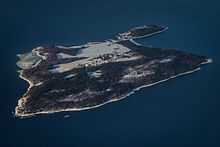Bastøy Prison
 Bastøy Prison from the air | |
| Location | Bastøy Island, Norway |
|---|---|
| Coordinates | 59°22′48.55″N 10°31′29.65″E / 59.3801528°N 10.5249028°ECoordinates: 59°22′48.55″N 10°31′29.65″E / 59.3801528°N 10.5249028°E |
| Status | Operational |
| Security class | Minimum |
| Country | Norway |
| Website | bastoyfengsel.no |
Bastøy Prison (Norwegian: Bastøy landsfengsel) is a minimum-security prison on Bastøy Island, Norway, located in the Horten municipality about 75 kilometres (46 mi) south of Oslo. The prison is on a 2.6 square kilometre (1 sq mi) island and hosts 115 inmates. Arne Kvernvik-Nilsen,[1] governor of the prison, leads a staff of 69 prison employees. Of this staff, only five employees remain on the island overnight.[2] The prison is about one hour commuting distance from Oslo.[3]
Once a prison colony for young boys, the facility is trying to become "the first ecological prison in the world".[2] Reoffending rates have been reported at 16%, compared to a European average of around 70%.[4] Inmates are housed in wooden cottages and work the prison farm.[5] During their free time, inmates have access to horseback riding, fishing, tennis, and cross-country skiing.[2][6] The only access to the prison is from a ferry that departs from Horten.[7]
Bastøy Boys' Home Insurrection
Before the current prison, the island was occupied by a juvenile detention centre, Bastøy Boys' Home. The Norwegian government purchased the island in 1898 for 95,000 kroner, and the reformatory opened in 1900. In 1915, it was the site of an insurrection by the boys which was suppressed by the Norwegian military; this event was later dramatised in the 2010 film, King of Devil's Island. The Boys' Home was taken over by the Norwegian government in 1953 and shut down in 1970.[8]
The rebellion occurred on 20 May 1915, when between 30 and 40 boys rallied around four youths who had escaped and been recaptured. The group refused to work, armed themselves with farming tools and stones, cut the telephone lines and then burned down the barn with stolen matches and cigars. The same barn had been burned down two years before.
When instructors and guards failed to quell the riot, the military was called in. Over a hundred troops stormed the island. Also on scene were two seaplanes, two submarines, and the armored ship "Norway" from the naval base Karljohansvern in Horten. Several of the boys escaped into the forest but were later recaptured. Officials identified the ringleader of the rioters as a newly arrived 18-year-old "gypsy boy" plumbing apprentice from Christiania. Three others were identified as his accomplices.
The 1915 uprising did not end the school's strict disciplinarian methods which continued until 1953 when the Ministry of Social Affairs took over operations. The school was shut down on 1 October 1970. Bastøy Island, once famous for its brutal reformatory, is now famous for the progressive Bastøy Prison founded in 1982 where inmates live in cottages, dine on food cooked by a chef, and enjoy a sauna, tennis courts and horseback riding.<ref name=CNN - Welcome to the world's nicest prison>CNN – Welcome to the world's nicest prison Retrieved 27 July 2012</ref>
Prison
In 2014, the prison was awarded the 2014 Blanche Major Reconciliation Prize for "promoting human values and tolerance".[9]
In popular culture
The prison colony was featured in the DVD extras for Michael Moore's 2007 documentary Sicko. In 2010, both a documentary about the island by Michel Kapteijns was released[10] and King of Devil's Island, a Norwegian film directed by Marius Holst.[11]
See also
References
- ↑ Henley, Paul (2012-05-18). "Crime and punishment, Norwegian style". BBC News Online. Retrieved 2013-03-07.
- ↑ 2.0 2.1 2.2 Kilner, James (2006-03-28). "Break the law and live by a beach". Environmental News Network. Reuters. Retrieved 2013-03-07.
- ↑ Vice staff (2011-08-03). "Inside Norway's progressive prison system". CNN. Retrieved 2013-03-07.
Rehabilitation is key in Norway prisons
- ↑ James, Erwin (4 September 2013). "Bastoy: the Norwegian prison that works". The Guardian (London). Retrieved 6 September 2013.
- ↑ Shishkin, Philip (June 8, 2003). "Norway's convicts take a number, line up for prison". Chicago Sun-Times.
- ↑ Hundley, Tom (October 19, 2003). "Norwegian Jails Break Concept Of Hard Time". Chicago Tribune. Retrieved 2012-05-20.
- ↑ Degen, Guy. "Norwegian Prison Prepares Inmates For The Outside World." Deutsche Welle. 25 March 2009. Retrieved on 24 May 2012.
- ↑ O'Sullivan, Michael (2011-12-16). "King of Devil's Island (Kongen av Bastoy)". Washington Post. Retrieved 2012-06-19.
Nordic gloom at boys' colony
- ↑ Schau, Mette Stensholt; Bjerkeseth, Anders Wam (30 October 2014). "Pris til Bastøy fengsel". NRK (in Norwegian). Retrieved 1 November 2014.
- ↑ Bastoy the Movie — documentary by Michel Kapteijns Retrieved 2 February 2010
- ↑ Kongen av Bastøy (King of Devil's Island) — film by Marius Holst Retrieved 2 February 2010
External links
- Bastoy Prison website http://www.statsbygg.no/prosjekter/prosjektkatalog/585_bastoy/html/foto/f_01.html (Norwegian)
- Bastoy Prison Photos http://www.jus.uio.no/ikrs/ekskursjon/fengslet/talking_about_pictures.html
- Sutter, John D. "Welcome to the world's nicest prison." CNN. 24 May 2012.
- Norway's controversial 'cushy prison' experiment - could it catch on in the UK?
- Adams, William Lee. "Sentenced to Serving the Good Life in Norway." "TIME". 12 July 2010.